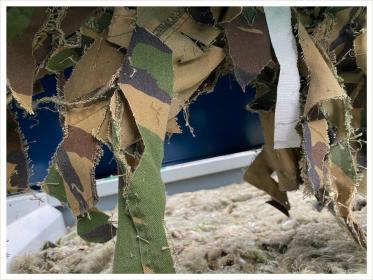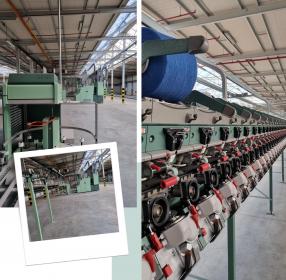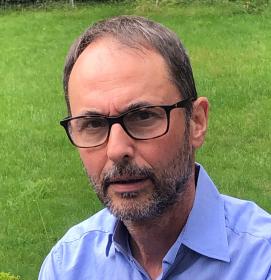Circular Economy: It could all be so simple... or not
Interview with Henning Wehland & Robert Kapferer, Circularity Germany
I'm a very curious guy by nature. That's why I offered to help out at a well-known hot dog station in Münster (Germany) this year, to draw attention to the shortage of staff in the gastronomy. I wrote an article about it on LinkedIn, which was in turn reacted to by Ines Chucholowius.
From her profile, I could see that she is a consultant for strategic marketing and communication in the textile industry. Not entirely serious, she offered me a job in her office. Like pushing a button, the pictures in my mind set in: Textile industry, exciting! Merchandising, contacts in the industry, collaborations, and I agreed to a short chat, at the end of which we spoke on the phone and arranged to meet.
She told me about her website TEXTINATION.de. And we were already involved in an exciting, heated exchange about perception and truth in the textile industry. Without further ado, we left it at that and I went home with a chunk of new information about an exciting field. Our dialogue on social media continued and eventually Ines offered me the chance to feed my die-hard curiosity with the support of TEXTINATION.de. I could write a blog on the site, about people, products, service providers, producers, startups or trends that interest me, to add to my half-knowledge about the textile industry.
Textile waste into the front ... new T-shirt out the back
During this exchange and a long brainstorming session, certain terms kept tickling my attention:
Circular economy, recycling, recyclable material loops. Circular Economy, Recycling, Recyclables. Even though there are many different definitions and some even distinguishing between different aspects: the former thought from waste that flows back into production as a secondary raw material, a more modern approach avoiding waste already in production - the general consensus is really only that circular economy is a cycle in which waste is used as a source for something new.
Sounds like useful additions for all areas of the manufacturing real economy to me. Ines introduced me to Robert Kapferer: He runs a startup called Circularity Germany in Hamburg. His company, founded in 2021 and consisting of Robert and another partner, is an offshoot of the Dutch-based company Circularity B.V. Its founder Han Hamers, with a degree in child psychology and a professional background in the textile dyeing industry, had the idea five years ago for a production facility that spins new yarn exclusively from textile production waste and old textiles turning it into T-shirts, polo shirts and sweatshirts.
Whether this works, and if so, how, is what I wanted to find out, and Ines and I arranged to meet Robert for a 90-minute online conference.
Robert, originally an industrial engineer, comes from a less sustainable industry. He worked for 11 years as managing director for AVECO Material und Service GmbH, where he was responsible for the workwear of more than 50,000 employees.
At the beginning of our conversation, he emphasizes that a moment in January 2021 changed his life and from then on, he wanted to dedicate himself to the topic of circular economy with all his might. That was when he met Han Hamers, who inspired him to found Circularity Germany. His enthusiasm and passion for the subject sound credible, and he begins to describe the differences between chemical and mechanical recycling methods. In summary, the mechanical process of shredding and the subsequent spinning shortens the fibers and thus restricts their properties for further processing. The advantage lies primarily in the comparatively uncomplicated, fast and more cost-efficient process. In the chemical variant, chemical waste remains, but the processed materials are broken down again into their basic building blocks in such a way that they have almost all the same properties as a so-called virgin raw material. Circularity Germany stands for the mechanical process.
And then comes the sentence that gets all our attention: "We've advanced a spinning technology so much that it relies exclusively on waste-based raw materials."
This sentence almost doesn't stand out because Robert still talks - quite excitingly - about the fact that they are planning a production and manufacturing facility where everything from knitting yarn to relatively fine thread can be spun and then further processed into fabric. And here Ines and I ask intensively: Essential requirements for industrial production still seem to be unresolved, and necessary processes are still in the planning stage. For example, the question of whether to work with pre-consumer or post-consumer waste. Pre-consumer waste is cutting waste from the production of clothes, which corresponds to about 10% of the processed material. Post-consumer waste we know as used textiles.
As long as production still takes place in India, Circularity currently uses mainly pre-consumer waste. These come exclusively from sewing factories in the Tirupur region in the south of India. When using used textiles, which exist in large quantities in Germany (according to a study, 28-40% of all garments produced are thrown away unworn), Circularity produces blended yarns of cotton and polyester. The company does not offer pure cotton yarns.
Textiles are treated with chemicals to varying degrees - workwear in particular cannot do without them. The fact that Han Hemers is also collecting used textile stocks from the Dutch army in order to reintroduce them renewed into the consumer cycle is therefore not reassuring. Military clothing has to be finished with all kinds of additives.
Therefor I ask how he can dispel doubts in a consumer’s mind like mine, with a healthy half-knowledge of mask deals and greenwashing, that a well-intentioned vision will be followed by a dark awakening. This concern cannot yet be resolved after the conversation.
We limit ourselves to what is planned: Robert has the dream of reversing the globalized process of textile production. He wants to end the decoupling of cotton growing regions and far-flung production such as Asia with subsequent shipping of ready-made goods to Europe. In the future, existing used textiles and/or cutting wastes are to be collected on site, recycled and processed locally into new textiles.
I believe him in having this dream. However, some of my questions about sustainability remain unanswered - which is why I have my doubts about whether the idea is currently capable of performing and competing.
What are the reasons for this? For one thing, I think it's always difficult to do necessary pioneering work. Especially when listening to smart comments at the regulars' table that large companies are already working intensively on the principle of circular economy. But sometimes, apart from the term "circular economy" and a vague commitment to it, not much remains.
Circularity Germany is committed to developing a technology based exclusively on waste. The interview points out that this also includes making production more environmentally friendly and eliminating transport routes, which further reduces the burden on the environment. When all the requirements for realizing this dream have been met and a product that is competitive in terms of both quality and price can be launched on the market, it is up to the consumer to decide. Here one would have the credible argument of sustainability and a socially and environmentally fair process. Circularity would then not have to worry about PR.
It needs to be given time and, above all, attention. But perhaps the industry should get involved right here and now, and invest in startups like this and make sure that problems are cleared out of the way. Because one thing has become clear to us in this conversation:
It could all be so simple. Circular economy is achievable, but the road there is still costly and rocky. That's why we wish Robert and his team every success and, above all, perseverance. Thank you for the interview.
Short and sweet: the profile of the company in the attached factsheet for download.
Textination




